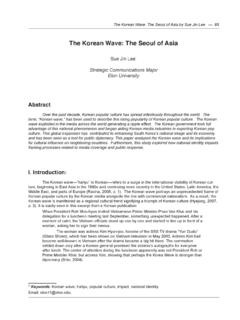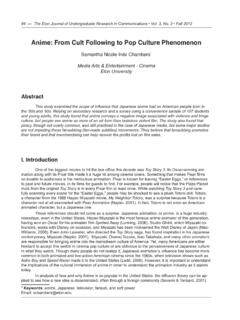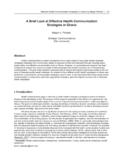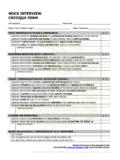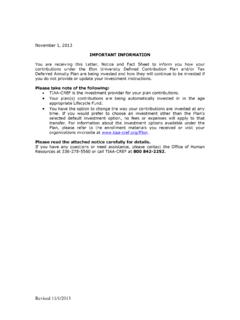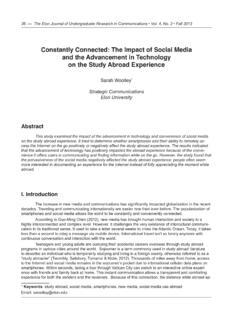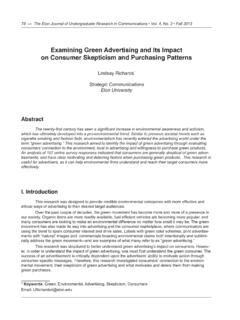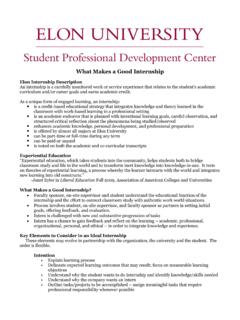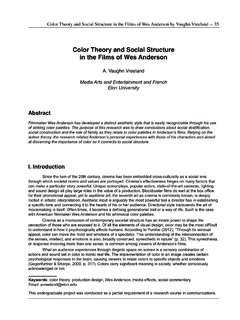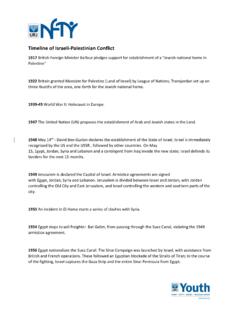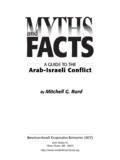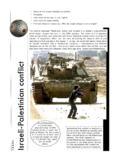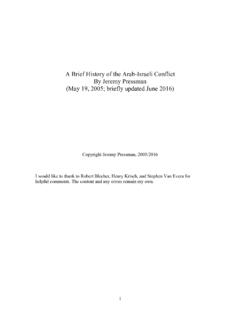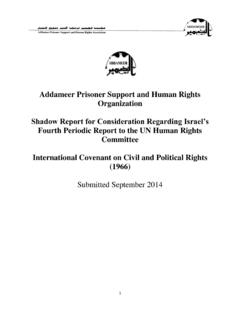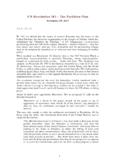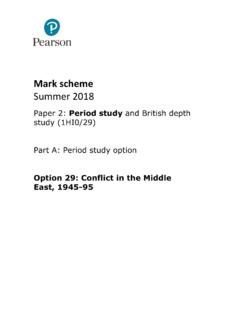Transcription of Understanding the Israeli-Palestinian Conflict
1 Global Classroom Workshops made possible by: THE NORCLIFFE FOUNDATION And World Affairs Council Members Understanding the Israeli-Palestinian Conflict A Resource Packet for Educators Compiled by Kristin Jensen, Jillian Foote, and Tese Wintz Neighbor May 12, 2009 Photo Courtesy of Bill TaylorHOW TO USE THIS RESOURCE GUIDE Please note: many descriptions were excerpted directly from the websites. Packet published: 5/11/2009; Websites checked: 5/11/2009 Recommended Resources Links that Lesson Plans & Charts & Graphs Teacher Resources Audio Video Photos & Slideshows Maps TABLE OF CONTENTS MAPS 1 FACT SHEET 3 TIMELINES OF THE Conflict 4 GENERAL RESOURCES ON THE Israeli-Palestinian Conflict 5 TOPICS OF INTEREST 7 CURRENT ARTICLES/EDITORIALS ON THE Israeli-Palestinian Conflict 8 (Focus on International Policy and Peace-Making)
2 THE CRISIS IN GAZA 9 RIPPED FROM THE HEADLINES: WEEK OF MAY 4TH 10 RELATED REGIONAL ISSUES 11 PROPOSED SOLUTIONS 13 ONE-STATE SOLUTION 14 TWO-STATE SOLUTION 14 THE OVERLAPPING CONUNDRUM THE SETTLEMENTS 15 Conflict RESOLUTION TEACHER RESOURCES 15 MEDIA LITERACY 17 NEWS SOURCES FROM THE MIDEAST 18 NGOS INVOLVED IN Israeli-Palestinian RELATIONS 20 LOCAL ORGANIZATIONS & RESOURCES 22 DOCUMENTARIES & FILMS 24 BOOKS 29 1 MAPS & Other excellent sources for maps: From the Jewish Virtual Library - Foundation for Middle East Peace - OR Integrated Regional Information Networks - 2 Source: BBC Source: CIA World Factbook Source: CIA World Factbook 3 FACT SHEET Source: CIA World Factbook ISRAEL WEST BANK GAZA STRIP UNITED STATES Area - Comparative slightly smaller than New Jersey slightly smaller than Delaware slightly more than 2x Washington, DC Similar to China.
3 More than 2x the EU Natural Resources timber, potash, copper ore, natural gas, phosphate rock, magnesium bromide, clays, sand arable land arable land, natural gas coal, copper, lead, phosphates, uranium, bauxite, gold, iron, mercury, nickel, potash, silver, tungsten, zinc, petroleum, natural gas, timber Land Use arable land: permanent crops: other: (2005) arable land: permanent crops: other: (2001) arable land: 29% permanent crops: 21% other: 50% (2002) arable land: permanent crops: other: (2005) Renewable Water Resources cu km (2001) no data no data 3,069 cu km (1985) Population 7,233,701 note: includes about 187,000 israeli settlers in West Bank, 20,000 in the israeli -occupied Golan Heights, & 177,000 in East Jerusalem (2009) 2,461,267 note: in addition, there are about 187,000 israeli settlers in the West Bank and fewer than 177,000 in East Jerusalem (2009) 1,551,859 (July 2009) 307,212,123 (2009) Population Growth (2009) (2009) (2009 est.)
4 (2009 est.) Urban Population 92% of total pop. (2008) 72% of total pop. (2008) 72% of total pop. (2008) 82% of total pop. (2008) Life expectancy at Birth total population: yrs total population: yrs total population: yrs total population: yrs Ethnic Groups Jewish (Israel-born , Europe/America-born , Africa-born , Asia-born ), non-Jewish (mostly Arab) (2004) Palestinian Arab and other 83%, Jewish 17% Palestinian Arab white , black , Asian , Amerindian and Alaska native , native Hawaiian and other Pacific islander , two or more races (2007) Religion Jewish , Muslim 16%, Arab Christians , other Christian , Druze , unspecified (2004) Muslim 75% (predominantly Sunni), Jewish 17%, Christian & other 8% Muslim (predominantly Sunni) , Christian Protestant , Roman Catholic , Mormon , other Christian , Jewish , Buddhist , Muslim , other , unaffiliated , none 4% (2007) Literacy total population: male.
5 Female: (2004) total population: male: female: 88% (2004) total population: male: female: 88% (2004) total population: 99% male: 99% female: 99% (2003) Government Type parliamentary democracy Israel-occupied Israel-occupied Constitution-based federal republic Suffrage 18 ; universal no data no data 18 ; universal GDP per capita (PPP) $28,200 (2008) $2,900 (2008) $2,900 (2008 est.) $47,000 (2008) Unemployment (2008) (June 2008) (June 2008) (Dec. 2008) Military Service Age and Obligation 18 for compulsory (Jews, Druzes) & voluntary (Christians, Muslims, Circassians) service; both sexes (2008) In accordance with peace agreement; not permitted conventional military forces (2008) In accordance with peace agreement.
6 Not permitted conventional military forces (2008) 18 years of age (17 years of age with parental consent) for male and female voluntary service Refugees and Internally Displaced Persons IDPs: 150,000-420,000 (Arab villagers displaced from homes in northern Israel) (2007) refugees (country of origin): 722,000 (Palestinian Refugees (UNRWA)) (2007) refugees: million (Palestinian Refugees (UNRWA)) (2007) refugees: admitted 62,643 during 04/05; 10,586 (Somalia); 8,549 (Laos); 6,666 (Russia); 6,479 (Cuba); 3,100 (Haiti); 2,136 (Iran) (2006) 4 TIMELINES OF THE Conflict Below are links to timelines of the history of the Arab- israeli Conflict . Please be aware that any timeline is fraught with dangers.
7 Israelis, Arabs, and palestinians would develop very different timelines. Each would include events that would not be included on the others' timelines. And each would provide very different descriptions for events they all include. Therefore, it is important to consult a number of different timelines to get a sense of which events the various groups consider important and how they understand those events. - Professor Bill Taylor A HISTORY OF THE Israeli-Palestinian Conflict PROMISES PBS (2001) The history of the Palestinian- israeli Conflict is elastic; it changes dramatically depending on who is telling it and where they start the story. Therefore, it is important to note that a historic timeline of events concerning this Conflict is always difficult to present in an objective manner.
8 For this reason, as you read through the Timeline sections, certain events include both a Palestinian (in green) and an israeli (in blue) perspective. To explore the Timeline, click one of the four highlighted sections: 1880-1936, 1947-1973, 1974-1988 or 1991-2001. The information on the israeli perspective was put together using the israeli Government s official Web site, produced by Israel s Ministry of Foreign Affairs. Information on the Palestinian perspective was compiled using the Palestinian National Authority s official Web site and the Palestinian National Authority s Ministry of Information s Web site. Other History Sites: The Israeli-Palestinian Conflict in a nutshell MidEast Web israeli -Arab/ Israeli-Palestinian Conflict Timeline 1967-2007 The Foundation for Middle East Peace Israel Factsheet The Economist Mideast Crisis BBC Peace cannot be achieved through violence; it can only be attained through Understanding .
9 Ralph Waldo Emerson We all know there are two sides to any argument, but the key to discussing real prospects for peace is by truly Understanding the other side s opinions, perspectives, and concerns without using volatile language, demonizing your adversary, or unfairly dominating the debate. Keeping an open mind and open ear can be extremely difficult when it comes to controversial topics, such as the Israel-Palestine Conflict , but no solution will ever succeed unless we all try to step outside of our comfort zones and listen to opinions and ideas we may not agree with. We might then discover common ground we would not have found if the discussion had not taken place, and it can start with one person, one idea, one discussion, one acknowledgement, just one.
10 5 GENERAL RESOURCES ON Israeli-Palestinian Conflict More than ever before in human history, we share a common destiny. We can master it only if we face it together. Kofi Annan TEN THINGS STUDENTS NEED TO KNOW ABOUT THE ORIGINS OF ISRAEL AND PALESTINE (April 2008) As the sixtieth anniversary of Israel s independence in May 2008 approaches, that country remains a focal point of world attention, as it has been since its birth. The state s origins do much to explain why the Arab- israeli Conflict has been so hard to resolve, but also provides a glimpse of the possibilities of peace. Here are ten things for students to know, along with ten things for them to research. PROCON Israeli-Palestinian presents statistics, maps, timelines, historical documents, photos, and pro and con statements on questions related to the Israeli-Palestinian Conflict .
